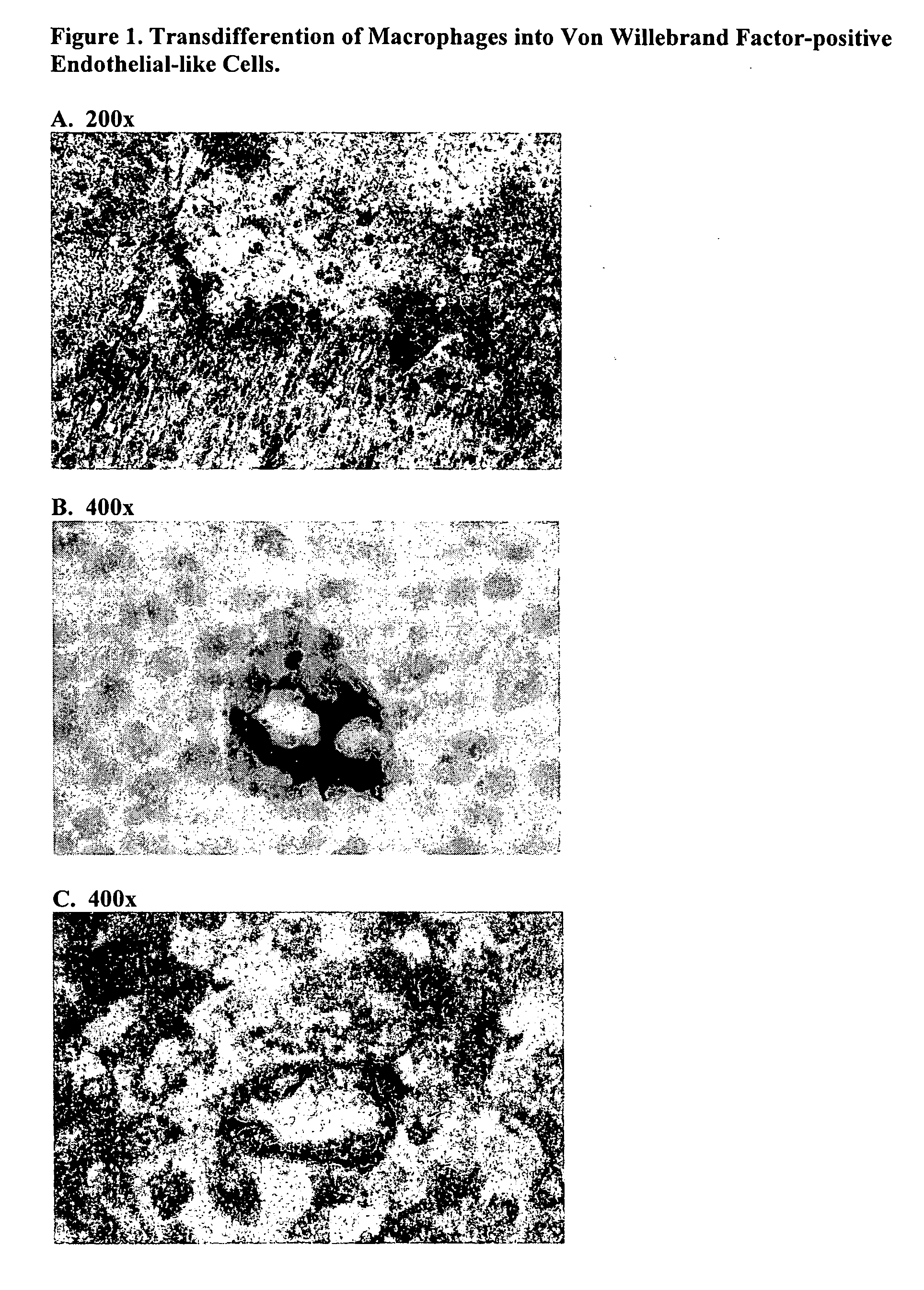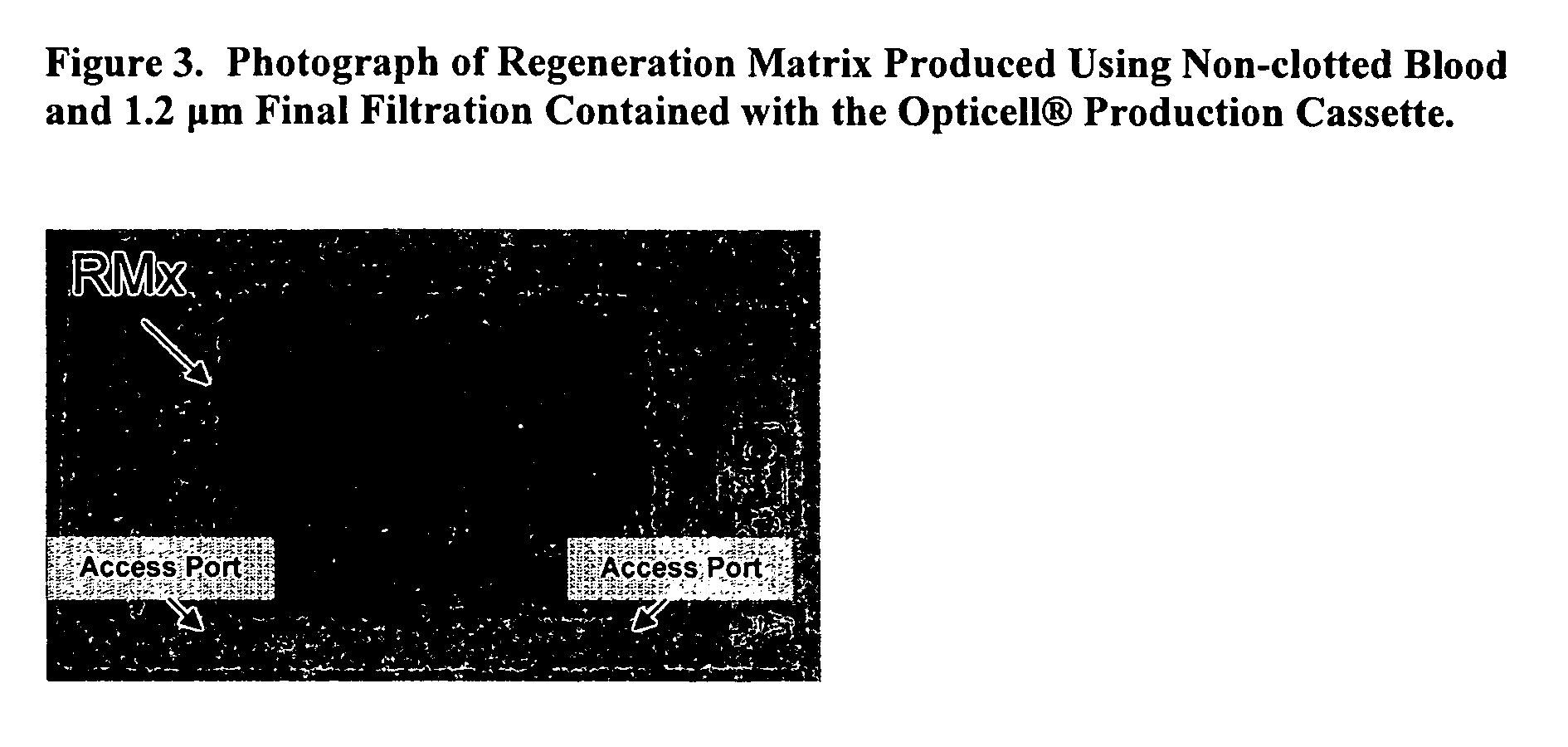Acellular bioabsorbable tissue regeneration matrices
a bioabsorbable tissue and regeneration matrix technology, applied in the direction of drugs, peptide/protein ingredients, prosthesis, etc., can solve the problem that human beings and veterinary applications typically do not represent therapeutic modality, and achieve the effect of increasing the biological activity of surrounding tissue and promoting tissue autoregeneration
- Summary
- Abstract
- Description
- Claims
- Application Information
AI Technical Summary
Benefits of technology
Problems solved by technology
Method used
Image
Examples
example 1
Derivation of Regeneration Matrix from Whole Clotted Blood
[0097] Venous blood was procured from healthy donors (Research Blood Components, Brighton, Mass.) in 12 ml vaccutainers®, allowed to clot at RT for at least 30 min and frozen at −20 C until use. Processing was initiated by subjecting the blood to 5 freeze (−20 C)— thaw (RT) cycles. The contents of the vaccutainer containing 10 ml of blood were emptied into a sterile mortar. The clot was disrupted by manual grinding using a sterile pestle with the addition of process medium which consisted of a 1:1 mixture of DMEM (Mediatech, Hemdon, Va.) and Ham's F12 (Mediatech) supplemented with 2×ITS supplement (Gibco / Invitrogen, Gaithersburg, Md.), 20 ng / ml recombinant human EGF (R&D Systems, Minneapolis, Minn.), and 40 ng / ml recombinant human bFGF (R&D Systems). During the grinding procedure, liquid containing liquefied whole blood clot and process medium was aspirated from the mortar using a sterile 25 ml serological pipette and transf...
example 2
Derivation of Regeneration Matrix from Whole Blood Collected Using Anticoagulant
[0098] Venous blood was procured from healthy donors (Research Blood Components, Brighton, Mass.) in 12 ml vaccutainers® containing Na4-EDTA and frozen at −20° C. until use. Processing was initiated by subjecting the blood to 5 successive freeze (−20° C.)—thaw (RT) cycles. The contents of the vaccutainer containing 10 ml of blood was emptied into a sterile container and process medium (see Example 1) added to a final volume of 200 ml and the solution mixed gently. This starting material was gravity filtered through a 40 μm mesh strainer. The filtrate was collected and centrifuged at 500×g for 30 min and the supernatant passed through a 5 μm syringe filter directly into Opticell® cassettes at 10 ml each. The Opticell® cassettes were incubated at 37° C. and 7.5% CO2 in air. After 6 to 8 days of incubation, 3 ml of fresh process medium was added to each Opticell® cassette. After that, 1.5 ml of fresh proce...
example 3
Derivation of Regeneration Matrix from Whole Blood Fractions Produced Using a Serial Filtration
[0101] The activity of the regeneration matrix was further refined by passing the supernatant from the centrifugation step (as listed in Examples 1 and 2) through 5 μm and 1.2 μm filter sets coupled together. This step removes larger particles from the starting material which results in altered functional properties. An example of the regeneration matrix structure within the Opticell® cassette is shown (FIG. 3). FIG. 4 shows that a regeneration matrix produced from whole blood does not show any indication of intact cells or nuclei. Hematoxylin staining was completely negative in all section analyzed but the material stains strongly with eosin. A beaded structure can be clearly resolved when using high numerical aperture lenses (high resolution). Besides the beaded structure which comprises most of the regeneration matrix, it is possible to observe small regions of flat sheets that seem to...
PUM
| Property | Measurement | Unit |
|---|---|---|
| time | aaaaa | aaaaa |
| time | aaaaa | aaaaa |
| time | aaaaa | aaaaa |
Abstract
Description
Claims
Application Information
 Login to View More
Login to View More - R&D
- Intellectual Property
- Life Sciences
- Materials
- Tech Scout
- Unparalleled Data Quality
- Higher Quality Content
- 60% Fewer Hallucinations
Browse by: Latest US Patents, China's latest patents, Technical Efficacy Thesaurus, Application Domain, Technology Topic, Popular Technical Reports.
© 2025 PatSnap. All rights reserved.Legal|Privacy policy|Modern Slavery Act Transparency Statement|Sitemap|About US| Contact US: help@patsnap.com



